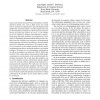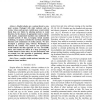74 search results - page 9 / 15 » Automated Worm Fingerprinting |
83
Voted
ACSAC
2004
IEEE
15 years 2 months ago
2004
IEEE
Large-scale attacks generated by fast-spreading or stealthy malicious mobile code, such as flash worms and e-mail viruses, demand new approaches to patch management and disinfecti...
ECIS
2001
15 years 13 days ago
2001
This paper presents a case study showing how Repertory Grid Analysis (RGA) can be used to construct shared meaning during information systems development, implementation and use. ...
105
click to vote
VIZSEC
2004
Springer
15 years 4 months ago
2004
Springer
This paper examines the dramatic visual fingerprints left by a wide variety of popular network attack tools in order to better understand the specific methodologies used by attack...
COMPSEC
2008
14 years 11 months ago
2008
Abstract-- Rootkit attacks are a serious threat to computer systems. Packaged with other malware such as worms, viruses and spyware, rootkits pose a more potent threat than ever be...
ACSAC
2005
IEEE
15 years 4 months ago
2005
IEEE
An increasing variety of malware, such as worms, spyware and adware, threatens both personal and business computing. Remotely controlled bot networks of compromised systems are gr...



